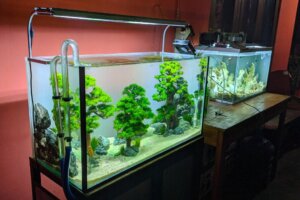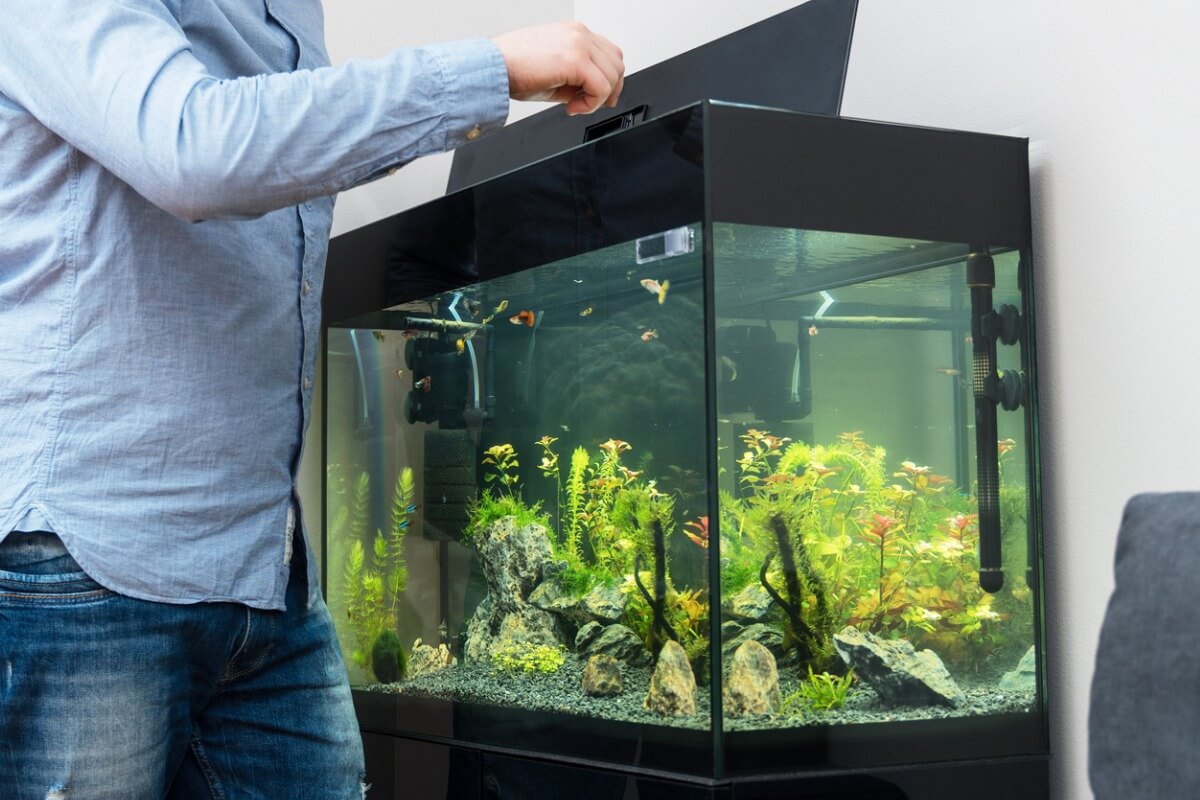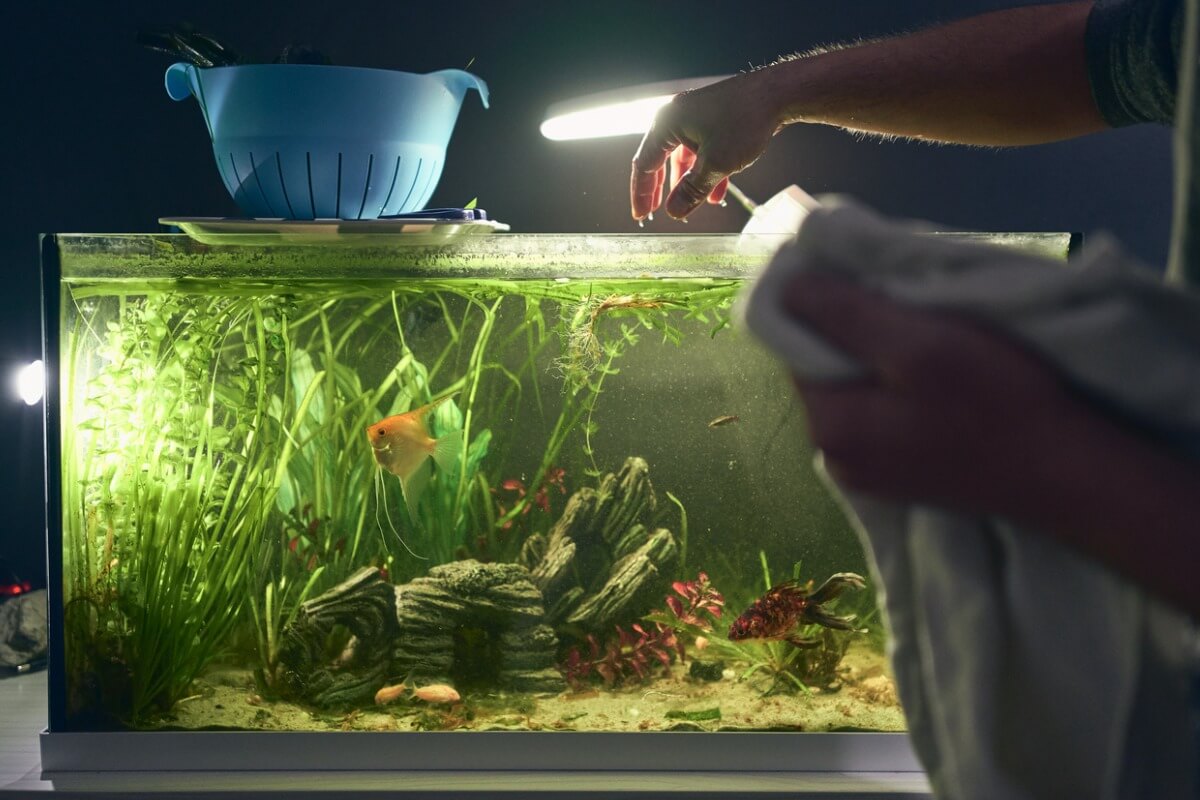My Aquarium is Leaking: What's the Cause?


Written and verified by the biologist Cesar Paul Gonzalez Gonzalez
Aquariums are one of the most sought-after home decorations nowadays, because of the beautifully colored fish you can house in them. However, problems can often occur, and you’ll need to be careful when trying to resolve them. An example of this are aquariums that lose water, since this can modify the chemical parameters that keep fish healthy. Find out what to do if your aquarium is leaking in this article.
Although water loss in an aquarium is easy to solve, you’ll need to identify the source of the problem to avoid problems in the future. In the worst case scenario, it’ll be necessary to replace a panel of glass in the tank. Read on and find out the reasons why an aquarium loses water.
How do I detect if the aquarium is leaking?
The best way to detect water loss in the tank is with a visual sign on the outside of the glass – some kind of mark or label on the glass outside the aquarium that will indicate the current volume of water it holds. This way, you’ll be able to easily see if it has decreased in level.
Some people use a tape measure to get an approximate idea of how much is missing.

Why does an aquarium lose water?
There are two reasons why an aquarium loses water: leaks and evaporation. Both are fairly simple to solve and don’t usually affect the life of the fish. However, remember that water loss also impacts the chemical parameters of the tank, so it must be replenished quickly to avoid other types of problems.
Evaporation from the aquarium
The tank will lose some of its liquid naturally. This is due to the fact that the aquarium lighting heats up the surface of the water and will start an evaporation process which lowers the level of the fluid. In addition to this, the difference in ambient temperature also creates this situation, and some places are more prone to water loss than others.
In short, the water heats up and gradually escapes as it turns into a gas. This event is more common in reef aquariums because of the temperatures and light (both very different parameters than outdoors). Also, people who use sump filters lose more liquid due to the configuration of their tank.
How do I prevent aquarium evaporation?
Contrary to popular belief, a lid that hermetically seals the tank isn’t the best option. This is because the liquid also needs air to oxygenate. This may prevent water loss, but it will cause bacteria and other components to come into contact with the fish. As a result, fish could easily become poisoned or get sick.
Evaporation in the aquarium is a process that can’t be completely eliminated. However, it can be reduced by using other accessories. Some ways to achieve this are as follows:
- Buying self-filling systems: This is an automatic mechanism that allows the water level to rise again when it drops to a certain point.
- Keeping only cold-water fish: By having fish that are adapted to cold water, evaporation is greatly reduced by the negligible difference between the temperature range of the aquarium and the outside temperature.
- Get aquariums with thick glass: Glass tends to heat up very quickly when it’s thin, so by increasing the width, the temperature doesn’t rise so easily.
Leaks in the aquarium
If your aquarium is leaking, it could be due to small cracks in the glass. In these cases, the liquid level drops gradually, in a very similar way to what happens with evaporation. However, glass fractures cause waterlogging, which can be detected by checking the tank environment.
How can I repair aquarium leaks?
To repair aquarium leaks, you’ll first need to check the severity of the fracture. If the glass has a small crack, you can use silicone to fix it temporarily. However, if the crack is quite long then it’s best to replace the whole panel of glass. In both cases, you’ll need to empty the tank to carry out the repair.
Remember that the silicone must be 100% neutral in order to be able to use it in aquariums. Otherwise, when it comes into contact with water, it could release toxic substances and poison the fish. Also, make sure that all repairs are carried out on the inside of the tank so as not to affect its visual aesthetics.
Is it good to fix the aquarium with silicone?
Silicone is the “glue” that’s used to join the different panels on your aquarium. Because of this, there’s no risk if, as we mentioned earlier, you use the correct type of silicone. However, if you repair a small crack with it, then you need to keep in mind that this is only a temporary method, and you’ll have to replace the glass sooner rather than later. Don’t leave the crack for too long or you could risk the tank breaking completely.

My aquarium is leaking: attention is the best prevention
As you’ll now have realized, aquariums lose water on a regular basis. However, it’s best to carry out daily checks to ensure there are no cracks, as both the aquarium itself and the fish can be affected in such a situation.
Remember that any lost water should be replaced as soon as possible to avoid endangering your fish. As long as you continue to be attentive to the needs and condition of your fish, you’ll avoid any potential problems.
Aquariums are one of the most sought-after home decorations nowadays, because of the beautifully colored fish you can house in them. However, problems can often occur, and you’ll need to be careful when trying to resolve them. An example of this are aquariums that lose water, since this can modify the chemical parameters that keep fish healthy. Find out what to do if your aquarium is leaking in this article.
Although water loss in an aquarium is easy to solve, you’ll need to identify the source of the problem to avoid problems in the future. In the worst case scenario, it’ll be necessary to replace a panel of glass in the tank. Read on and find out the reasons why an aquarium loses water.
How do I detect if the aquarium is leaking?
The best way to detect water loss in the tank is with a visual sign on the outside of the glass – some kind of mark or label on the glass outside the aquarium that will indicate the current volume of water it holds. This way, you’ll be able to easily see if it has decreased in level.
Some people use a tape measure to get an approximate idea of how much is missing.

Why does an aquarium lose water?
There are two reasons why an aquarium loses water: leaks and evaporation. Both are fairly simple to solve and don’t usually affect the life of the fish. However, remember that water loss also impacts the chemical parameters of the tank, so it must be replenished quickly to avoid other types of problems.
Evaporation from the aquarium
The tank will lose some of its liquid naturally. This is due to the fact that the aquarium lighting heats up the surface of the water and will start an evaporation process which lowers the level of the fluid. In addition to this, the difference in ambient temperature also creates this situation, and some places are more prone to water loss than others.
In short, the water heats up and gradually escapes as it turns into a gas. This event is more common in reef aquariums because of the temperatures and light (both very different parameters than outdoors). Also, people who use sump filters lose more liquid due to the configuration of their tank.
How do I prevent aquarium evaporation?
Contrary to popular belief, a lid that hermetically seals the tank isn’t the best option. This is because the liquid also needs air to oxygenate. This may prevent water loss, but it will cause bacteria and other components to come into contact with the fish. As a result, fish could easily become poisoned or get sick.
Evaporation in the aquarium is a process that can’t be completely eliminated. However, it can be reduced by using other accessories. Some ways to achieve this are as follows:
- Buying self-filling systems: This is an automatic mechanism that allows the water level to rise again when it drops to a certain point.
- Keeping only cold-water fish: By having fish that are adapted to cold water, evaporation is greatly reduced by the negligible difference between the temperature range of the aquarium and the outside temperature.
- Get aquariums with thick glass: Glass tends to heat up very quickly when it’s thin, so by increasing the width, the temperature doesn’t rise so easily.
Leaks in the aquarium
If your aquarium is leaking, it could be due to small cracks in the glass. In these cases, the liquid level drops gradually, in a very similar way to what happens with evaporation. However, glass fractures cause waterlogging, which can be detected by checking the tank environment.
How can I repair aquarium leaks?
To repair aquarium leaks, you’ll first need to check the severity of the fracture. If the glass has a small crack, you can use silicone to fix it temporarily. However, if the crack is quite long then it’s best to replace the whole panel of glass. In both cases, you’ll need to empty the tank to carry out the repair.
Remember that the silicone must be 100% neutral in order to be able to use it in aquariums. Otherwise, when it comes into contact with water, it could release toxic substances and poison the fish. Also, make sure that all repairs are carried out on the inside of the tank so as not to affect its visual aesthetics.
Is it good to fix the aquarium with silicone?
Silicone is the “glue” that’s used to join the different panels on your aquarium. Because of this, there’s no risk if, as we mentioned earlier, you use the correct type of silicone. However, if you repair a small crack with it, then you need to keep in mind that this is only a temporary method, and you’ll have to replace the glass sooner rather than later. Don’t leave the crack for too long or you could risk the tank breaking completely.

My aquarium is leaking: attention is the best prevention
As you’ll now have realized, aquariums lose water on a regular basis. However, it’s best to carry out daily checks to ensure there are no cracks, as both the aquarium itself and the fish can be affected in such a situation.
Remember that any lost water should be replaced as soon as possible to avoid endangering your fish. As long as you continue to be attentive to the needs and condition of your fish, you’ll avoid any potential problems.
All cited sources were thoroughly reviewed by our team to ensure their quality, reliability, currency, and validity. The bibliography of this article was considered reliable and of academic or scientific accuracy.
- Rottmann, R. W., & Campton, D. E. (1989). Technical Notes: Multiple-Tank Aquarium System with Recirculating Water for Laboratory Studies of Freshwater Fishes. The Progressive Fish-Culturist, 51(4), 238-243.
- Wolfenden, D. (2016). Breaking Down the Marine Aquarium. UltraMarine Magazine, (59), 66.
- Clark, J. R. (1964). Sea-water systems for experimental aquariums: a collection of papers (Vol. 63). US Bureau of Sport Fisheries and Wildlife.
- Kidd, A. H., & Kidd, R. M. (1999). Benefits, problems, and characteristics of home aquarium owners. Psychological Reports, 84(3), 998-1004.
- Shannon, S. (1984). Aquarium Maintenance Manual. University of Hawaii: Honolulu.
- Datta, S. (2012). Aquarium Water Quality Management. FISHCOOPS Edition: XXVI (III), 9-16.
This text is provided for informational purposes only and does not replace consultation with a professional. If in doubt, consult your specialist.








